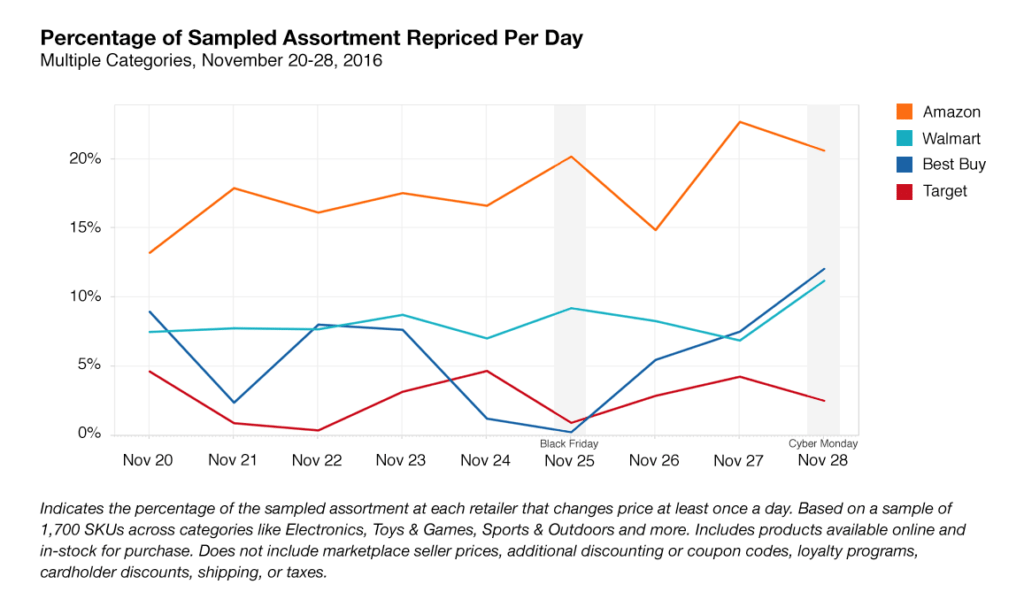Cyber Monday sets a new online record with $3.45 billion in sales despite reported decline in consumer interest — but how?
According to Adobe Digital Insights, Cyber Monday closed off Thanksgiving’s holiday shopping frenzy by breaking online records, yielding $3.45 billion in single-day sales. As the chart below indicates, Cyber Monday’s online sales grew 12.1% since last year and beat out Black Friday’s online sales by $110 million!
|
2015 |
2016 |
|
|
Thanksgiving |
$1.73B |
$1.93B |
|
Black Friday |
$2.72B |
$3.34B |
|
Cyber Monday |
$2.28B |
$3.45B |
This may come as a surprise to some, as JDA’s 2016 Consumer Survey reported a significant decline in consumer interest in Black Friday and Cyber Monday as a result of year round discounting by retailers and new ecommerce events such as Amazon’s Prime Day and Alibaba’s Single’s Day. With the blurring of key shopping dates, here are three strategies major retailers used to win shoppers over this Cyber Monday, as observed by 360pi.
Promotional Strategies: Out with Black Friday, In with Cyber Monday Deals
This year, shoppers witnessed some interesting promotional plays by retailers in advance of Thanksgiving weekend. Many retailers like Amazon, Walmart, and Best Buy announced Black Friday and Cyber Monday deals that spanned beyond the key shopping dates. For example, Target unveiled their 10 Days of Deals promotion, with new deals beginning Saturday, November 19 through Monday, November 28, including Cyber Monday deals offered the Sunday before.
In addition, Amazon extended their Cyber Monday from a day to a week, launching over 75,000 new deals for online shoppers.
Dynamic Pricing
When looking at how price dynamic major retailers were, Amazon, Walmart, and Best Buy were found to change prices more on Cyber Monday than on Black Friday, emphasizing the fact that Cyber Monday has become the largest shopping day of the year. In fact, Best Buy barely changed prices on Black Friday, but adjusted about 14% of products sampled on Cyber Monday. Similarly, Amazon’s price change percentage jumped from 20% on Black Friday to 22% on Cyber Monday, and Walmart increased the number of products they changed prices on from 8% of the sampled set on Black Friday to 12% on Cyber Monday.
Online vs. In-store: The Convenience Factor
If we look at the history of Cyber Monday, convenience has always been a factor in its success. In 2005, many consumers only had access to high-speed internet at work and would use it to begin their holiday shopping the first day they were back in the office, after the long Thanksgiving weekend.¹ Today, with the rise of mobile devices, tablets, and home Wi-Fi, the ease of shopping online and searching for the best deals is effortless.
Free Shipping
Free shipping has also played a factor in online shopping’s success. It’s such a high priority for online shoppers that 80% claimed that they spent more than intended in order to meet a free shipping threshold during Black Friday and Cyber Monday of last year.
Will Cyber Monday beat out Black Friday in 2017?
As online and mobile sales become more prevalent on Black Friday, how will retailers differentiate Cyber Monday deals? Will app exclusives be added to retail strategies? Will the continued greying of the holiday bleed into Halloween? One thing is for sure — Black Friday and Cyber Monday will continue to be the biggest shopping days of the year and retailers need to revamp their strategies if they want to be successful.
Jenn Markey is the VP Marketing for 360pi

